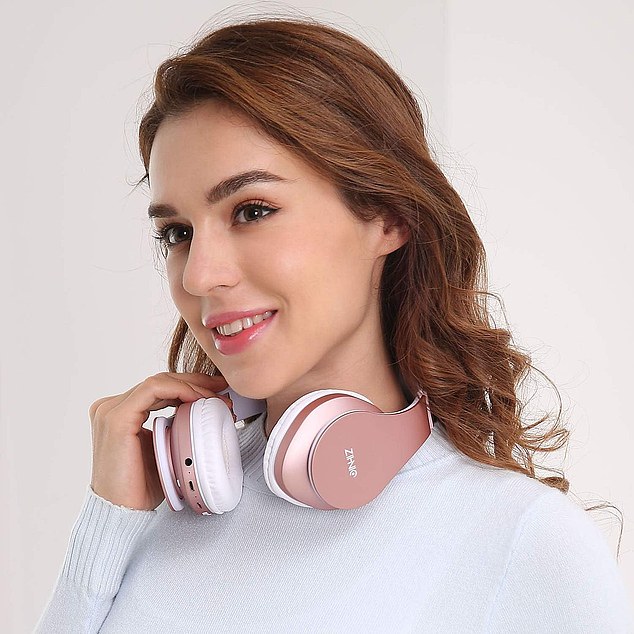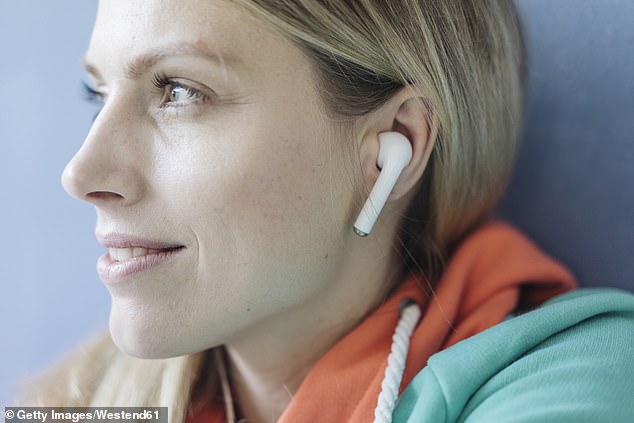Wireless headphones could lead to deafness because of the damaging levels of noise they transmit directly into the ear canal, scientists have warned.
Over-ear listening devices are said to be safer as they more effectively block out background noise, meaning users are less likely to turn up the volume on music or podcasts.
EU legislation and World Health Organisation guidelines state that the safe noise level for headphones is 100 decibels (dB), which is the same as the sound of an ambulance siren reaching your eardrum.
However, Dr Sam Couth, professor of audiology at the University of Manchester, warned that some headphones on the market reach 120dB – roughly equivalent to a chainsaw or a jet plane taking off.
Experts have warned that in-ear headphones could damage the fragile cells inside the ear, increasing the risk of long-term hearing loss.

Kim Kardashian was photographed in Los Angeles in 2021 sporting a pair of lilac headphones said to be the £199 wireless Beats Fit Pro.
“It’s not just the level of exposure that matters, but also the duration of exposure,” he said. The telegraph.
‘For an environment of 85 dB, the maximum safe exposure time is eight hours.
‘For every 3dB increase, the exposure time is halved, i.e. four hours for 88dB, two hours for 91dB, and so on.
‘So at 120 dBA, the maximum safe exposure time is about 30 seconds.’
Dr Harvey Dillon, professor of hearing sciences at the University of Manchester, added: “If over-ear headphones completely surround the ear, they are likely to block out background noise, meaning people are less likely to turn up the volume of their music, making them safer.”
Last year, a team of international scientists wrote in the journal BMJ Global Health that 1 billion people aged 12 to 34 worldwide are at risk of hearing loss due to headphone use and loud music venues.
They explained that the damage lies in the effect of loud noise on the thousands of tiny hairs in the inner ear that are responsible for translating vibrations into sound.
Overstimulation of these fragile hairs can cause them to break and not regenerate, resulting in hearing loss.
Experts say that noise-cancelling features in many devices, as well as noise-cancelling headphones, can help reduce the overall noise level and, as a result, prevent any hearing damage.
However, it is not a magic solution.
Dr Couth says noise cancellation can be a “good thing” because “the music you’re trying to listen to isn’t competing as much with background noise, so there’s less need to turn up the volume.”
But not all devices have adequate noise cancellation, he says. “It is still possible to reach potentially harmful sound levels with noise cancellation on.”

Over-ear headphones are believed to block out more background noise than in-ear headphones, reducing the need to turn up the volume on your device.
Professor Michael Stone, a senior researcher at the University of Manchester, added that the “screech” of Tube trains was unlikely to be “muffled” by noise-cancelling features as it was “very high-pitched”.
However, over-ear headphones can be an effective solution, he says.
A survey earlier this year found that 40 percent of 18- to 44-year-olds who received loud noise alerts on their phones said they ignored the warning.
Around half of respondents to the survey by hearing and vision specialists Specsavers said they had received such a warning.
Gordon Harrison, chief audiologist at Specsavers, recommends a “60/60 rule” when using earphones or any other type of hearing aid.
“The general rule is to use headphones for only 60 minutes a day, at up to 60 percent volume,” he said.


